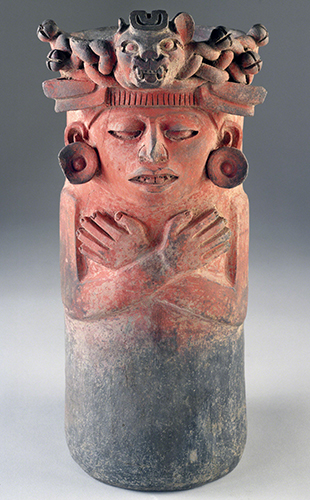Hispanic Heritage Month: Zapotec
We’re going to celebrate Hispanic Heritage Month (September 15th through October 15th) with a blog series featuring art gems from a variety of cultures in Mexico. The cultures of ancient Mexico rival any art you can throw at me from what nineteenth-century Western European art historians considered the high point of aesthetics, ancient Greece and Rome. Not only were the ancient Mexican cultures innovators in sophisticated art in all media, they were also brilliant engineers, mathematicians, and astrologers. Their complex glyph languages have yet to be completely translated. So here is our art historical ode to ancient Mexico for Hispanic Heritage Month.
The first major civilizations to emerge in the Americas were in Mesoamerica (Mexico, Honduras, Guatemala, Costa Rica, El Salvador, and Panama). The historic periods of Mexico roughly coincide with the rise and fall of the major urban centers, a series of independent city-states that controlled regions around and beyond them: Pre-Classic (ca. 1800 BCE–200 CE), Classic (ca. 200–900 CE), Late Classic (ca. 900–1000 CE), and Post-Classic (ca. 1000–1500s).
 |
| Zapotec Culture, Urn, ca. 300 BCE–200 CE. Ceramic with deposit of vermillion, 16 9/16" x 8" x 9" (42.1 x 20.3 x 22.8 cm). © 2019 Worcester Art Museum. (WAM-381) |
Ceramic arts were a significant art form of Mesoamerican peoples from the time of the Olmec (ca. 1500 BCE–100 CE) culture on. The most important objects were vases and jars meant to hold offerings in tombs, and incense burners that were used during religious and burial ceremonies. This vessel from the Zapotec culture (ca. 700 BCE–1521 CE) is typical of the cylinder-type containers found in most Zapotec tombs. Such urns usually held precious objects such as jadeite knife blades, jadeite beads, and shell jewelry. While the exact purpose of the vessels is unknown, they may have held objects considered necessary to the deceased's afterlife.
These funerary urns are typically topped with a figure. This early example is decorated with a headdress containing bells and a miniature jaguar head, indicating perhaps the status of the deceased as a warrior. Later funerary urns had such elaborate decorative headdress that often the faces were obscured. This vessel has traces of vermillion applied during firing.
The Zapotec culture was centered in the valley of Oaxaca in southern Mexico, bordering the lands of the Olmec culture, Mexico’s oldest urban society. At its height (ca. 500 BCE–700 CE), the Zapotec culture was ruled from the magnificent city of Monte Albán, which contained almost 17,000 people. Like the Olmec, the Zapotec had a far-flung trading network through which they spread their religion and arts.
Monte Albán replaced (ca. 500 BCE) an earlier city, San José el Mogote, also in the Oaxaca Valley, founded between 1600 and 700 BCE. Monte Albán was a city of stepped, pyramidal temples; palaces; tombs; and walls covered in hieroglyphics. The Zapotec were primarily an agrarian culture with significant achievements in irrigation, and the development of sophisticated ceramic arts, which they traded with other cultures.
Check back Wednesday for my Hispanic Heritage Month series post about Teotihuacán.


Comments